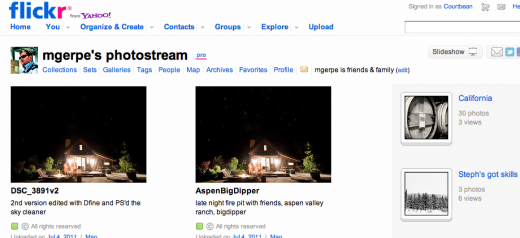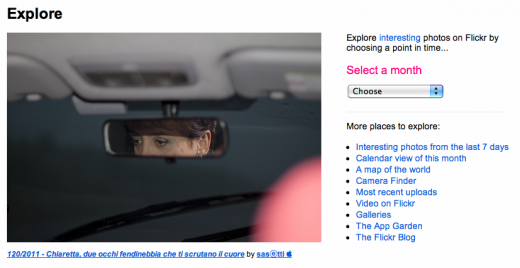
The fate of Flickr has long been in question since Yahoo! decided to sunset Delicious many months ago. For the past several years, the site, which was founded in 2004, has remained stagnant, unchanged with the exception of thousands of new members and a few social features.
The site looks dated, there is a growing amount of MySpace-ish spam, showcasing large photos is awkward, the iPhone app is slow (there is no iPad app) and activity on Flickr feels a little “walled” off from the rest of the web.
Dozens of competitive companies have popped up but none have had held much clout. Photography, being a visual art, attracts those with an eye for beauty, so its unsurprising that all the cool kids are moving their best work over to 500px because of its simple portfolio building tools and easy-to-navigate user interface.
500px vs. Flickr
In the past few months, what I would consider a large number of photographers, have made their way to the Toronto-based 500px.com through word of mouth through the Twitterverse and Facebook. While the site doesn’t necessarily have the same features and functionality that Flickr has, the site does one thing extremely well: Display photographs. They also provide a portfolio site for members, with more options for paying subscribers. Many of the portfolio templates are very clean-looking and they all seem to load pretty fast. For those of us who are selling most of our work to art directors & photo editors, this is a good thing…In my opinion, we’re in the early stages of seeing 500px.com take a nice tasty bite out of Flickr’s market.
If you are a professional artist, which home page would you prefer?


It’s a pretty obvious choice for most: 500px, a Tortonto-based startup was launched in October 2009 by founders and photographers Oleg Gutsol and Ian Sobolev with the idea to gather the best photographs in one place. In June 2011, the site received $525,000 in Series A funding with with investment from High Line Venture Capital, Deep Creek Capital and ff Venture Capital. The site lets photographers create contemporary portfolios with optional themes that are separate from the photostream. Portfolio also has sections for Biography and Contact. In fact, this makes it a great ready made website solution for photographers who are web challenged.
500px is less of a storage unit like Flickr and more of an artist’s collective. In a May interview with Gigaom, Gutsol, one of the site’s two co-founders said: “We see Flickr more as a photo storage site, where anyone can upload all their photos in one place and share them with their friends. We’re interested in getting the best photography in the world in one place, and growing the best photography community.”
Social: On Flickr, you can add a contact, friend or family and those relationships can either be asynchronous or mutual. In the same way and similar to Twitter, you “Follow” other photographers on 500px, as well as favorite and save their images. But unlike Flickr, within minutes of uploading your images, you can expect feedback from the 500px community, complete with a “like” based voting system. The social engagement on 500px blows Flickr out of the water. Maintain a blog, write on a friend’s wall, view their activity newsfeed style and even view their friend’s photos all on 500px.

Explore: Photos can be viewed from the home page by Popular, Editor’s Choice, Favorites, Upcoming, Fresh and Blogs. You can even select to include nude photos in your search unlike the prudes at Flickr.

In comparison, have you ever seen photos this beautiful using Flickr’s Explore feature? It looks like this: 
Licensing & Sales: Most images on Flickr fall under Creative Commons, so the site is a free for all to spread beautiful images around the world without paying attention to copyright. Meanwhile, at 500px most photos are allowed to be shared for personal use, but are restricted from use on printed materials, online materials, books, cds, dvds, editorial materials, etc. So if you are a professional photographer who needs to earn money from his or her photos and doesn’t appreciate them being downloaded by bloggers like me, 500px definitely has its advantages. 500px also allows its users to sell their photos on the site, and 500px collects a 5% commission on all printing sales.
Costs: A premium account with unlimited uploading will set you back $50 per year vs. Flickr’s $25 per year. But with the paid version on 500px you can link your photostream to a custom domain, an RSS feed, have the ability to remove all 500px branding from your stream (aka white label), it’s advertising free, and you’ll have the ability to hook your stream up to a Google analytics account to better monitor traffic and activity.
500px does have a few cons: 500px lays down the rules, and I don’t really like rules, so here they are:
- Choose only your very best photos Photos must belong to you
- Maximum filesize is 30 MB, larger files will not be added to the queue
- JPG file type only Your limit is 20 / 20 photos in a week.
- Upload up to 10 Photos at a time
- After the upload is done — add title, description, and tags to your photos, select a category and click save.
Uploading is manual, and slow because it’s all done through the web page. 500px says, “Please be patient — we are scaling your files and uploading them to the cloud. This takes some time, especially if your original files are large (because we store them too).”
What it still needs: A mobile app. A public API. Geolocation integration. And a way to declare photos are under a Creative Commons license if you do want to share your photos with bloggers like me. Photographer Ben Chase points out that 500px needs a Lightroom plugin to make it easy to upload to the site right from Lightroom including the ability to track and update photos from within the app.
In conclusion, 500px is not going to replace Flickr for the masses. When it comes to storing your memories in the cloud, Flickr’s ease of uploading, its legacy brand and its cheap price are going to keep amateur picture takers like me happy. But 500px is hot and will pave the way of online communities for professional photographers. The attraction and hype surrounding 500px should light a fire under Flickr to become more engaged with its community, up its game in terms of features and particularly its tired user interface.
In related news, learn how to turn Google+ into an online photography portfolio here.
Get the TNW newsletter
Get the most important tech news in your inbox each week.




